

Felix Whitham DSc,
23-9-1919 to 22-11-2009
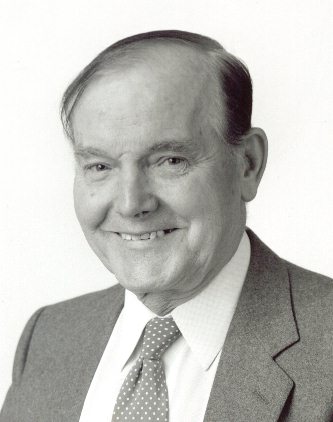
Dr Felix Whitham died unexpectedly on the morning of Sunday 22nd November 2009 from a heart attack. He had had a stroke a week before but was making a good recovery.
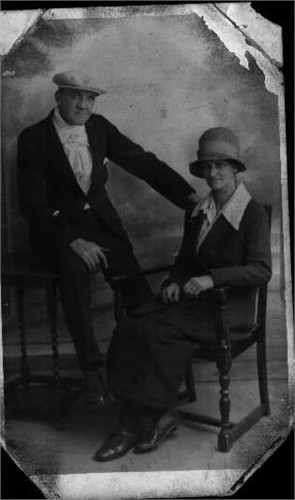
Felix's parents.
Felix was born in Hull in 1919, the son of James Robert Whitham and Lilian Florence Hutchinson. He had four brothers and one sister. The Whitham family history can be traced back to Richard Whitham who was born in Bradley Kildwick in the West Riding who died in 1623.
Felix's links with the Hull Geological Society went back a long way, though he did not realise it until later. As a young man, in 1936, Felix was an apprentice engineer in the motor trade to Sydney Rawlings. As an apprentice Felix worked on many vintage prestige cars such as Rolls Royces and made extensive notes about them in his notebooks, which he always kept. He had a driving licence at the age of 17 and remembered chauffeuring J W Stather and his wife to the shops. Stather was the long-serving Secretary of the HGS and although he was the owner of a successful wallpaper manufacturing business in Hull he did not drive. Felix remembered being reprimanded by Mrs Stather for throwing a toffee wrapper on the floor.
He joined the Territorial Army in 1937 and was called up at the start of the war. During the war Felix was in the Army as a mechanic for six and a half years. He was stationed near Glastonbury in Somerset at one time and drove his Austin Seven car without any road tax using a Guinness bottle label as a tax disk. I am not sure where the label came from because Felix did not often drink. Some friends borrowed the car one evening to drive to a dance nearby; in the blackout they turned it over in one of the many ditches, returning it to Felix without its roof. He left the car in farmer's barn when he was posted abroad and often wondered if it was still there. He escaped from Dunkirk and later he served in the Middle East and the North African deserts (Tubruk and El Alamein) running a field workshop that repaired damaged lorries. He later served in Palestine, Syria, Cyprus and Iraq. During his military service Felix was promoted through the ranks during the war to achieve the top non-commissioned Warrant Officer rank (WOI), the equivalent of an RSM! He was encouraged to seek a commission after the War but was keen to return to civilian life.
Felix had started to collect fossil "Devil's Toe Nails" and "Thunderbolts" as a lad along the shoreline at Ferriby and Hessle and in the quarries of Little Switzerland, travelling by bicycle. He was quite an energetic cyclist too; he told me how he would cycle to the Lake District to go camping or to London to visit relatives before there were many cars on the roads.
He was demobilised from the army in 1946 and took up the hobby of collecting fossils again. Those early geology days were spent collecting by himself without any formal geological education. He first visited the quarries at South Cave and South Newbald. Later he would travel to Whitby, Staithes and Robin Hood's Bay to collect ammonites.
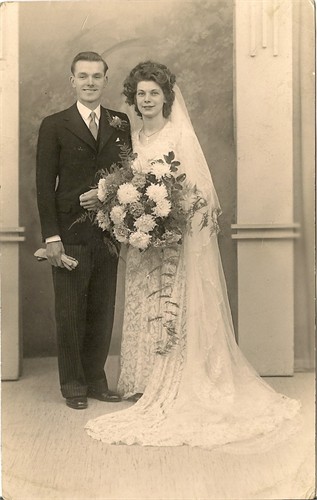
Felix and Doreen at their wedding
He married Doreen on 7th November 1947. They bought a five-year old house on Kingston Road, in 1947, which had a long garden. Felix built a shed between the lawn and the vegetable garden to house his collection of fossils. Their daughter Margaret would accompany Felix on some of his trips to local quarries and luckily was there and able to raise help when he had an accident in Sands Top Quarry one weekend. Margaret was educated in Hull and Felix was very proud of the fact that she was Head Girl at Newland High School, "when it was a good school".
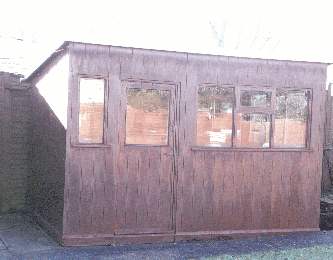
After the war he returned to the motor trade working for Paragon Motors. Because of his experience he was called up to serve in the Korean War but did not go due to family reasons. Paragon Motors was bought by the Kenning Motor Group in the 1950s. By the time he retired in 1984 he was the General Manager of a large Kenning's Rover dealership on Boothferry Road in Hull, supervising 180 garage staff, with the aid of notes on his trusty clipboard. He loved old cars and remembered driving a vintage single-cylinder vintage car on the annual rally to Scarborough. The exhaust fell off just as he arrived and he drove it along the sea front with it sounding like a machine gun and disturbing all the seagulls on the cliffs to the applause of the crowd! He was a keen supporter of the trade's professional body. In the 1960s he was the Honorary Secretary of the Hull Centre for the Institute of the Motor Industry. He was keen to support apprentices through that organisation and personally by mentoring the young staff he supervised.
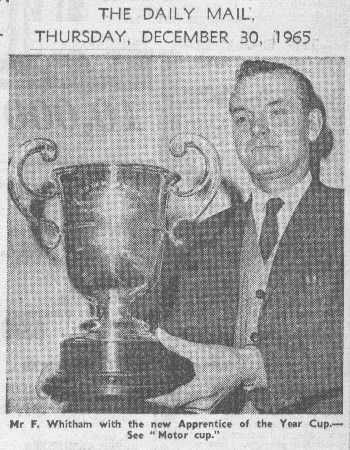
Felix told me that he saw a notice in the Hull Daily Mail about a meeting to reform the Hull Geological Society 1961 and went to the meeting. Patrick Boylan remembers that members of the Society had previously come across Felix in a Kellaways sandstone quarry when they were on a field trip and that the Secretary George de Boer encouraged Felix to join. Felix's own records (in the Society's archives) state that he joined the Society on 18th October 1961. He was elected to the Society's Committee in 1963 and became the Treasurer of the Society on 1st March 1965, a post he would hold until 28th February 2002. In the Society he became great friends with the President, Kenneth Fenton, who later was the Secretary for 12 years. They even went on a week-long geological exploration of the Cotswolds together. Felix particularly enjoyed collecting brachiopods around Leighton Buzzard on that trip.
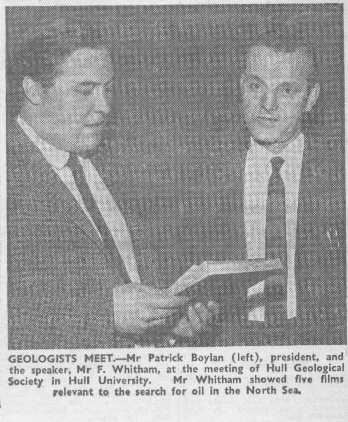
In the 1960s he also became a member of the Hull Museums Society and the Yorkshire Naturalists Union. In 1968 he moved from 125 Westlands Road in Hull to 2 Samman Close in Anlaby (which was later renumbered to no. 8). He continued to keep his growing geological collection in his shed, the floor of which eventually had to be reinforced to take the weight of the fossils!
He joined the Yorkshire Geological Society in 1974. He was a big supporter of the Society and in particular the Annual Dinner, arranging for a party from Hull to attend each December and offering lifts to the event. He and Hubert Watson loved the drive home from York to Hull, when meteorite showers were often visible in the clear night sky. When Mavis May organised the Annual Dinner he would help her with the seating plans.
In 1984 the Hull Geological Society wanted to mark its forthcoming Centenary with a scientific project. Felix persuaded the Committee that the project should be to record the lithostratigraphy of the Yorkshire Chalk. He had already done some work on a few quarries and published stratigraphic logs in our journal Humberside Geologist. For the next four years a group of members visited the larger quarries in the Wolds and the coastal exposures, measuring the exposures and recording the fossil horizons. The initial stratigraphy results were displayed at meetings of the Yorkshire Geological Society and the Association of the Teachers of Geology in 1987. There was a big display of the Society's History and local fossils at our Centenary Meeting in June 1988, which included many of Felix's fossils and material we had collected for the Centenary Project.
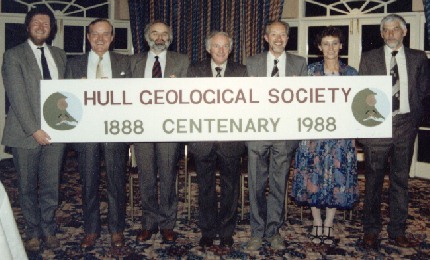
Felix had a fantastic memory; I never remember seeing him with a field notebook though he did record measurements on a clipboard when we did the logging for the Chalk Project. He did not catalogue his huge collection of fossils with catalogue numbers, yet he could tell you the name of each one and remember where and when he had found it. When he led fieldtrips he would produce impressive hand-outs for those attending, with long faunal lists of the fossils that could be found at the sites. He spent a considerable amount of time preparing these, carefully cutting and pasting stratigraphic details and drawings of fossils from various publications in the days that this was done with scissors and glue rather than a scanner and software! Some of these field trip notes were later published in Humberside Geologist.
Felix published the reports on the stratigraphy of the Yorkshire Chalk in the Proceedings of the Yorkshire Geological Society in 1991 and 1993, with the editorial help of Pete Rawson and John Neale. All the work was typed by Felix; the figures were hand-drawn and then the wording carefully typed on to them. In later years he used a computer, but I could never persuade him to save documents on the computer - he preferred to produce the complete work and print it out at one sitting. He read the papers to the Yorkshire Geological Society, at their meeting at the British Geological Survey in Keyworth in March 1991. Felix thought this was a great honour and was quite nervous. The President complimented him on the quality of the research; saying that it was a shame that professional geologists no longer had the time to carry out dedicated fieldwork over a large number of years in the same way.
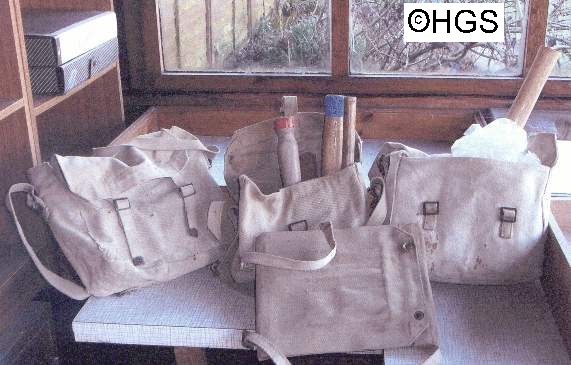
Following the publication of the papers: Felix was awarded a Collector of the Year prize by the Geological Curators' Group in 1991, an award to Amateur Palaeontologists by the Palaeontological Association in 1992, the R H Worth Prize of the Geological Society in 1992, the Sorby Medal of the Yorkshire Geological Society in 1993 and an honorary Doctorate of Science by the University of Hull in 1992. I was so pleased to see an amateur scientist with no formal training receive this recognition. Felix did not know it but we had nominated him for the degree in the Society's Centenary year, but were told to apply again once he had published. As an honorary graduate Felix was invited to dinner by the Vice-Chancellor, Professor David Dilks; Felix wondered if he should take a bottle of wine but was persuaded to take a fossil as a gift instead. He became good friends with the Vice Chancellor and was invited to several other events. They also shared an interest in old cars; Prof Dilks had an R-Type Bentley that was being restored.
Felix had a knack for finding fossils that only a few possess. Fossils seemed to leap out of the rocks into his rucksack. He spent many weekend afternoons in local quarries or he would drive to Lincolnshire to South Ferriby, Nettleton or Kirton Lindsey - a long journey before the Humber Bridge opened. When young members or beginners joined the Society and asked me how to find fossils I would tell them just to follow Felix and pick up anything he rejected.
He was an excellent preparator of fossils too and was quite innovative in his methods, making a wooden vice to hold the specimens still whilst he patiently chiseled away the matrix. He also revealed to me how his Jurassic ammonites always looked so impressive - he used Cherry Blossom light tan shoe polish on them to enhance their appearance. I think that modern museum conservators perhaps do not recommend this! Another innovation was the use of a home-made wooden rake on the top of the Carstone at Melton Bottoms to collect rare brachiopods. He published a joint paper about these in 1968. He also used the spark-plug-cleaning machine at the garage to grit-blast the chalk matrix off his Chalk sea urchins in his lunch breaks!
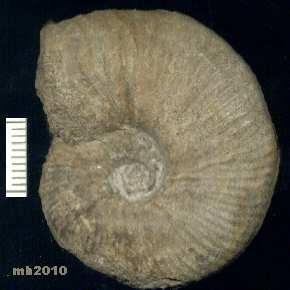
He was always keen to display fossils from his collection at geological meetings and other events. He had glued fossils onto display boards for this purpose. These boards fitted into four wooden cabinets that he had designed and built himself. All the fossils had carefully typed labels. I remember that for several years he and I went to the annual charity open day at South Ferriby Cement Works to put on a display in the large marquee. Felix was unable to put on a small display at meetings, though, bringing with him as much material as he could fit into the boot and back seats of his Rover.
He donated most of his impressive collection of East Yorkshire fossils to the British Geological Survey. His collection of Chalk Inoceramid bivalves is of particular importance. Some specimens of this collection are on public display in the Hull and East Riding Museum. Some of his Jurassic ammonites have been figured in monographs.
As well as his interest in geology, Felix was an active member of the army veterans association, often organising their annual re-union dinner, and the motor trade association. All his close friends will remember the Christmas cards that he sent with prints of vintage cars on them in aid of the Benevolent Fund of the Motor Industry. He also joined the local photographic society and had an impressive collection of rare coins.
The last few years of his life were spent caring for Doreen as her memory slowly faded, and as a result his mobility declined due to problems with his knees. Doreen died in January 2008. He is survived by one daughter, three grandsons, one granddaughter and two great-grandchildren.
I shall miss him hugely. Felix introduced me to what some geologists disparagingly call "the great white ooze", and we spent many long hours together trying to log every centimetre of it. I had to take care not to get any mud in his car though; he always took great pride in his cars, always Rovers. When I arrived home late I would blame Felix and when he arrived home late he would tell Doreen it was my fault! He proved to me, and a few others, that there are fossils in the Chalk too. Having measured the Yorkshire Chalk we organised a trip to Norfolk to see some more Chalk. Felix stayed with my family in a cottage for a week - he insisted on bringing his pressure cooker with him.
For seventeen years we worked together to organise the Hull Geological Society meetings and it is thanks to his careful Treasurership that the Society's funds have allowed us to keep membership fees so low.
He was always willing to share his knowledge and even at ninety his knowledge of Chalk fossils was the best. The day before he died I was shown a Chalk ammonite and I advised the owner to "take it round to Felix when he gets out of hospital". If only he could!
Mike Horne (August 2010)
References -
Anon 1992. Collector of the year, 1991. [F Whitham incl. photo.] Geologists' Association Circular 890, 8-9.
Anon 1992. Honorary Graduands December 1992. [incl. F Whitham] Bulletin [of the University of Hull] 12, 1+14.
Anon 1992. R H Worth Prize: Mr Felix Whitham. Geoscientist vol 2, no. 4
Benfield A C 1994. Society Proceedings 1993... Medal presentations ... Presentation of the Sorby Medal by the President to Felix Whitham DSc. Proceedings of the Yorkshire Geological Society, 50, 187-8.
Horne M 1988. The Centenary Chalk Project of the Hull Geological Society. Humberside Geologist 6, 19-20.
- 1989. The History of the Hull Geological Society. Humberside Geologist 7, 40pp.
- 1992. A Bibliography of East Yorkshire Geology 1938 to 1988. Humberside Geologist 9, 46 pp.
- 2000. Felix Whitham. A web-page of Hull Geological Society. http://www.hullgeolsoc.org.uk/whitham.htm
- 2010. Obituary. Felix Whitham (1919-2009). Proceedings of the Yorkshire Geological Society 58, 141.
- 2020 A Bibliography of East Yorkshire Geology 1989 to 2014 Humberside Geologist Online
Acknowledgements.
I wish to thank Ann Emery, Maggie Evans, Patrick Boylan and Terry Rockett for their help in preparing this obituary.
Copyright - Hull Geological Society 2021
Registered Educational Charity No. 229147